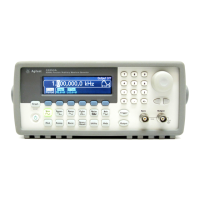88
Chapter 4 Calibration Procedures
Pulse Edge Time Adjustment
4
Pulse Edge Time Adjustment
The function generator stores calibration constants used to calculate the
slope and offset of the edge time DAC outputs. These setups output
100 Hz pulses with 5 ms pulse widths. The setups, following the first
three, must be done in pairs (i.e., 107 immediately before 108).
1 Set the oscilloscope to 50Ω input termination (if your oscilloscope does
not have a 50Ω input termination, you must provide an external
termination). Measure the rise time from the 10% to 90% points on the
waveform. Make the connections shown on page 87.
2 Use an oscilloscope to measure the rise time of the output signal at the
front-panel Output connector for each setup in the following table.
* Constants are stored after completing this setup.
1
Rise time measured can vary greatly from the nominal values shown.
3 Using the numeric keypad or knob, adjust the displayed rise time
(10% to 90%) at each setup to match the measured rise time.
Select ENTER VALUE.
4 There are no specific operational verification tests for the Pulse Edge Time
Adjustment. Continue with the next adjustment procedure in this chapter.
Nominal Signal
Setup Freq Amplitude Rise Time
1
104 100 Hz 1 Vpp 3.2 ns Fastest transition range 0
105* 100 Hz 1 Vpp 4.5 ns Mid transition range 0
106* 100 Hz 1 Vpp 64 ns Slowest transition range 0
107 100 Hz 1 Vpp 8 ns Fastest transition range 1
108* 100 Hz 1 Vpp 241 ns Slowest transition range 1
109 100 Hz 1 Vpp 161 ns Fastest transition range 2
110* 100 Hz 1 Vpp 4.9 µs Slowest transition range 2
111 100 Hz 1 Vpp 2.6 µs Fastest transition range 3
112* 100 Hz 1 Vpp 82 µs Slowest transition range 3
113 100 Hz 1 Vpp 57 µs Fastest transition range 4
114* 100 Hz 1 Vpp 1.75 ms Slowest transition range 4

